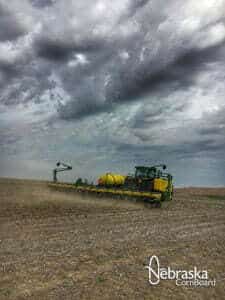 LINCOLN, Neb. – Nebraska corn farmers will plant 9.6 million acres of corn in 2017 according to the latest Prospective Plantings report released by the U.S. Department of Agriculture (USDA). This is down 3 percent from last year’s total planted corn acres.
LINCOLN, Neb. – Nebraska corn farmers will plant 9.6 million acres of corn in 2017 according to the latest Prospective Plantings report released by the U.S. Department of Agriculture (USDA). This is down 3 percent from last year’s total planted corn acres.
If these planting estimates hold up, Nebraska corn farmers will invest nearly $2.5 billion dollars into the state’s economy over a two-month period. This amount is a result of inputs, such as seed, fuel and fertilizer, but does not include land costs, labor or equipment. Despite the seemingly high investments now, the full economic impact will be realized over time.
“$2.5 billion is a significant investment made by Nebraska’s corn farmers. However, that investment is made at a critical time, as planting sets the foundation for the entire corn growing season,” said Boone McAfee, director of research at the Nebraska Corn Board. “Planting is just the first step in the corn value-added supply chain. As corn is converted into meat, bioplastics, ethanol, and other products, the full economic impact of Nebraska’s corn industry far exceeds the initial investment.”
Farmers historically begin to plant their corn crops in mid-April and try to finish by mid-May. However, weather often dictates when farmers can plant. This year’s moderately dry winter caused concern over available soil moisture during planting time. The latest Nebraska Crop Progress and Condition report released by the USDA (for the week ending April 16, 2017), indicated topsoil moisture supplies in Nebraska rated 5 percent very short, 18 percent short, 74 percent adequate and 3 percent surplus.
“Each year, farmers strive to produce a high quality corn crop using less resources and by managing inputs efficiently,” said David Merrell, farmer from St. Edward and chairman of the Nebraska Corn Board. “Nebraska has long been the third largest producer of corn in the United States, which has greatly enhanced our state’s rural and urban economies.”
Even though the corn industry is an economic booster for Nebraska, farmers face challenges in the months ahead.
“Continued low prices coupled with higher input costs continue to make margins slim for the producer. It’s important for us to always seek out and invest in new market opportunities to enhance the value and demand for corn,” said Merrell. “Global trade is also vital to our industry.”
Nationally, farmers are estimated to plant nearly 90 million acres of corn in 2017, which is down 4 percent from last year. If realized, this will be the lowest planted acreage since 2015, when U.S. farmers planted 88 million acres of corn.
As of the USDA’s latest April 17, 2017 – Crop Progress Report (released April 17, 2017), the U.S. has planted 6 percent of its corn crop. Nebraska is 3 percent complete.
The Nebraska Corn Board is a state funded agency funded through a ½-cent-per-bushel checkoff on all corn marketed in the state. The mission of the Nebraska Corn Board is to promote the value of corn by creating opportunities. Checkoff funds are invested in programs of market development, research, promotion and education.
The Nebraska Corn Board is made up of nine farmer directors who serve three-year terms. Eight members represent specific Nebraska districts and are appointed by the Governor of Nebraska. The Board elects a ninth “at large” member.
Related Articles
The Nebraska Corn Board Is Seeking Applications for Ethanol Infrastructure Grant Program
The Nebraska Corn Board (NCB) is accepting applications for the Ethanol Infrastructure Grant Program, which helps Nebraska fuel retailers add or expand higher ethanol blend options such as E15, E30 and E85. The program [...]

